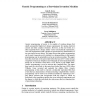Free Online Productivity Tools
i2Speak
i2Symbol
i2OCR
iTex2Img
iWeb2Print
iWeb2Shot
i2Type
iPdf2Split
iPdf2Merge
i2Bopomofo
i2Arabic
i2Style
i2Image
i2PDF
iLatex2Rtf
Sci2ools
96
Voted
EUROGP
1999
Springer
1999
Springer
Genetic Programming as a Darwinian Invention Machine
Genetic programming is known to be capable of creating designs that satisfy prespecified high-level design requirements for analog electrical circuits and other complex structures. However, in the real world, it is often important that a design satisfy various non-technical requirements. One such requirement is that a design not possess the key characteristics of any previously known design. This paper shows that genetic programming can be used to generate novel solutions to a design problem so that genetic programming may be potentially used as an invention machine. This paper turns the clock back to the period just before the time (1917) when George Campbell of American Telephone and Telegraph invented and patented the design for an electrical circuit that is now known as the ladder filter. Genetic programming is used to reinvent the Campbell filter. The paper then turns the clock back to the period just before the time (1928) when Wilhelm Cauer invented and patented the elliptic fi...
Related Content
| Added | 04 Aug 2010 |
| Updated | 04 Aug 2010 |
| Type | Conference |
| Year | 1999 |
| Where | EUROGP |
| Authors | John R. Koza, Forrest H. Bennett III, Oscar Stiffelman |
Comments (0)

